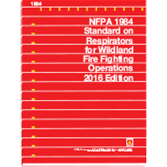
NFPA (Fire) 1984
- Comments Off on NFPA (Fire) 1984
- NFPA-FIRE
Codes and standards published by NFPA are displayed as read-only under license from NFPA solely for use within this system. NFPA material may not be downloaded, printed, reproduced, or transferred.
Developed by NIOSH, NPPTL, and NFPA®, NFPA 1984, Standard on Respirators for Wildland Fire Fighting and Wildland Urban Interface Operations, specifies respiratory protection for wildland fire-fighting operations.
The 2022 edition of NFPA 1984, Standard on Respirators for Wildland Fire Fighting and Wildland Urban Interface Operations, provides requirements for comprehensive respiratory protection equipment that wildland fire-fighting personnel can use to help protect against inhalation hazards. It also covers the increasing medical and health concerns facing fire fighters who have been exposed to products of combustion in wildland and urban interface fire-fighting conditions.
Wildland fire fighters frequently encounter lengthy exposures during fire-fighting operations, and the use of self-contained breathing apparatus (SCBA) is limited due to the duration of the breathing air supply. When developing the first edition of NFPA 1984, Standard on Respirators for Wildland Fire Fighting and Wildland Urban Interface Operations, the NFPA Technical Committee on Respiratory Protection Equipment worked closely with the National Institute for Occupational Safety and Health (NIOSH) and the National Personal Protective Technology Laboratory (NPPTL) to document the protection necessary in wildland fire-fighting environments.
The 2022 edition of NFPA 1984, Standard on Respirators for Wildland Fire Fighting and Wildland Urban Interface Operations, includes information about:
- An expanded range of protected personnel (including urban interface fire-fighters)
- A layered filtering approach for individual respiratory protection
- Typical use scenarios based on anticipated inhalation or hazard exposure
NFPA 1984, Standard on Respirators for Wildland Fire-Fighting and Wildland Urban Interface Operations, is essential for fire service personnel responsible for wildland fire-fighting operations, as well as for purchasers, manufacturers, certification authorities, and anyone concerned with wildland fire-fighter respiratory protection.
Stay up to date with the latest on respirators and their use in the field by ordering your copy of NFPA 1984, Standard on Respirators for Wildland Fire Fighting and Wildland Urban Interface Operations, today. (Print, 32 pp., 2022)
Product Details
- Published:
- 04/08/2021
- ANSI:
- ANSI Approved
- Number of Pages:
- 32

